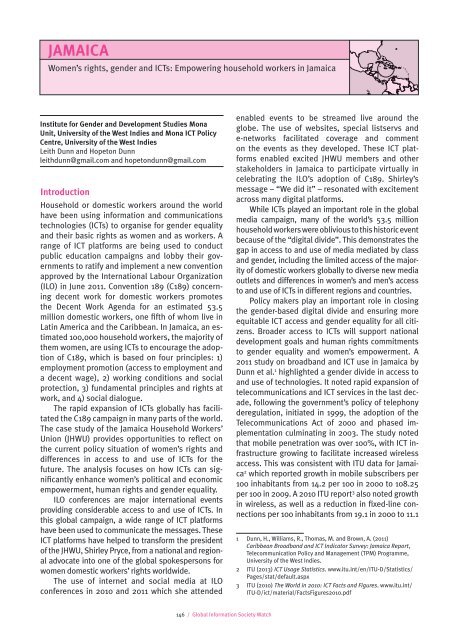gisw13_chapters
gisw13_chapters
gisw13_chapters
You also want an ePaper? Increase the reach of your titles
YUMPU automatically turns print PDFs into web optimized ePapers that Google loves.
jamaicaWomen’s rights, gender and ICTs: Empowering household workers in JamaicaInstitute for Gender and Development Studies MonaUnit, University of the West Indies and Mona ICT PolicyCentre, University of the West IndiesLeith Dunn and Hopeton Dunnleithdunn@gmail.com and hopetondunn@gmail.comIntroductionHousehold or domestic workers around the worldhave been using information and communicationstechnologies (ICTs) to organise for gender equalityand their basic rights as women and as workers. Arange of ICT platforms are being used to conductpublic education campaigns and lobby their governmentsto ratify and implement a new conventionapproved by the International Labour Organization(ILO) in June 2011. Convention 189 (C189) concerningdecent work for domestic workers promotesthe Decent Work Agenda for an estimated 53.5million domestic workers, one fifth of whom live inLatin America and the Caribbean. In Jamaica, an estimated100,000 household workers, the majority ofthem women, are using ICTs to encourage the adoptionof C189, which is based on four principles: 1)employment promotion (access to employment anda decent wage), 2) working conditions and socialprotection, 3) fundamental principles and rights atwork, and 4) social dialogue.The rapid expansion of ICTs globally has facilitatedthe C189 campaign in many parts of the world.The case study of the Jamaica Household Workers’Union (JHWU) provides opportunities to reflect onthe current policy situation of women’s rights anddifferences in access to and use of ICTs for thefuture. The analysis focuses on how ICTs can significantlyenhance women’s political and economicempowerment, human rights and gender equality.ILO conferences are major international eventsproviding considerable access to and use of ICTs. Inthis global campaign, a wide range of ICT platformshave been used to communicate the messages. TheseICT platforms have helped to transform the presidentof the JHWU, Shirley Pryce, from a national and regionaladvocate into one of the global spokespersons forwomen domestic workers’ rights worldwide.The use of internet and social media at ILOconferences in 2010 and 2011 which she attendedenabled events to be streamed live around theglobe. The use of websites, special listservs ande‐networks facilitated coverage and commenton the events as they developed. These ICT platformsenabled excited JHWU members and otherstakeholders in Jamaica to participate virtually incelebrating the ILO’s adoption of C189. Shirley’smessage – “We did it” – resonated with excitementacross many digital platforms.While ICTs played an important role in the globalmedia campaign, many of the world’s 53.5 millionhousehold workers were oblivious to this historic eventbecause of the “digital divide”. This demonstrates thegap in access to and use of media mediated by classand gender, including the limited access of the majorityof domestic workers globally to diverse new mediaoutlets and differences in women’s and men’s accessto and use of ICTs in different regions and countries.Policy makers play an important role in closingthe gender-based digital divide and ensuring moreequitable ICT access and gender equality for all citizens.Broader access to ICTs will support nationaldevelopment goals and human rights commitmentsto gender equality and women’s empowerment. A2011 study on broadband and ICT use in Jamaica byDunn et al. 1 highlighted a gender divide in access toand use of technologies. It noted rapid expansion oftelecommunications and ICT services in the last decade,following the government’s policy of telephonyderegulation, initiated in 1999, the adoption of theTelecommunications Act of 2000 and phased implementationculminating in 2003. The study notedthat mobile penetration was over 100%, with ICT infrastructuregrowing to facilitate increased wirelessaccess. This was consistent with ITU data for Jamaica2 which reported growth in mobile subscribers per100 inhabitants from 14.2 per 100 in 2000 to 108.25per 100 in 2009. A 2010 ITU report 3 also noted growthin wireless, as well as a reduction in fixed-line connectionsper 100 inhabitants from 19.1 in 2000 to 11.11 Dunn, H., Williams, R., Thomas, M. and Brown, A. (2011)Caribbean Broadband and ICT Indicator Survey: Jamaica Report,Telecommunication Policy and Management (TPM) Programme,University of the West Indies.2 ITU (2013) ICT Usage Statistics. www.itu.int/en/ITU-D/Statistics/Pages/stat/default.aspx3 ITU (2010) The World in 2010: ICT Facts and Figures. www.itu.int/ITU-D/ict/material/FactsFigures2010.pdf146 / Global Information Society Watch


